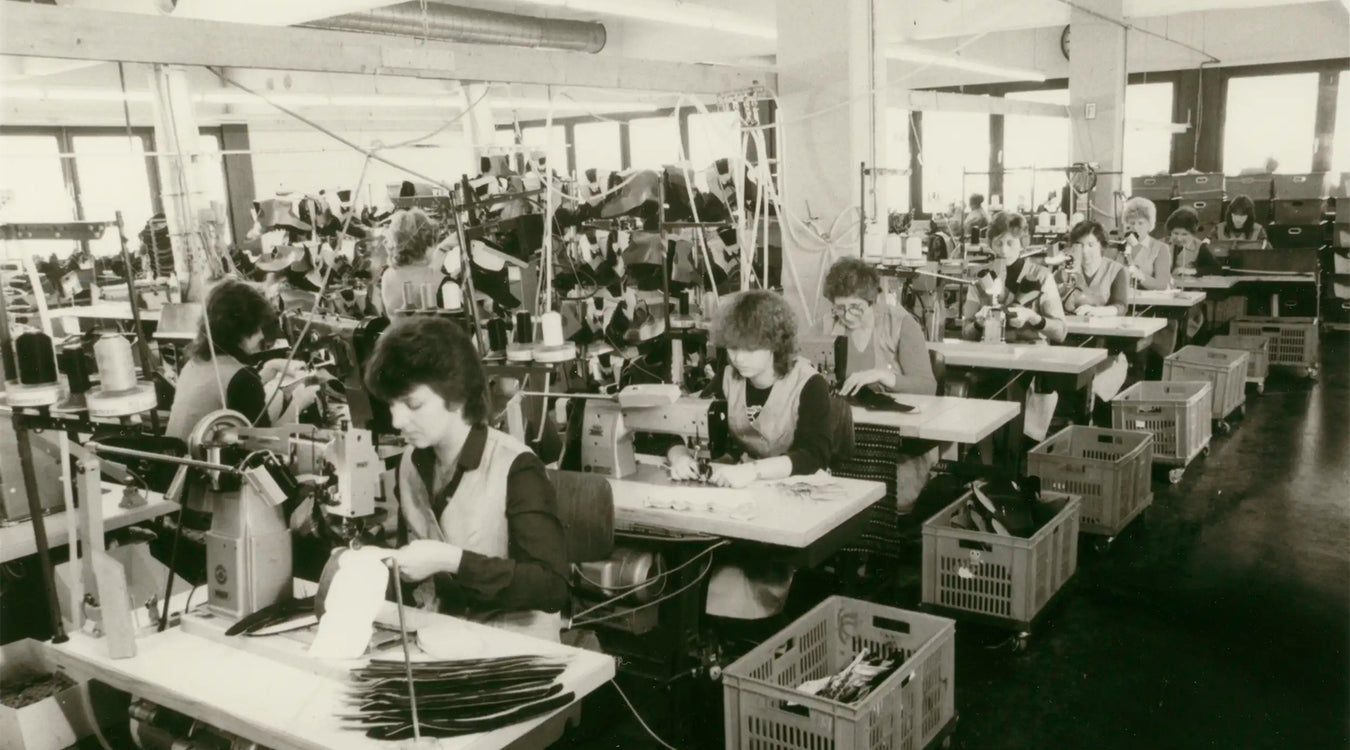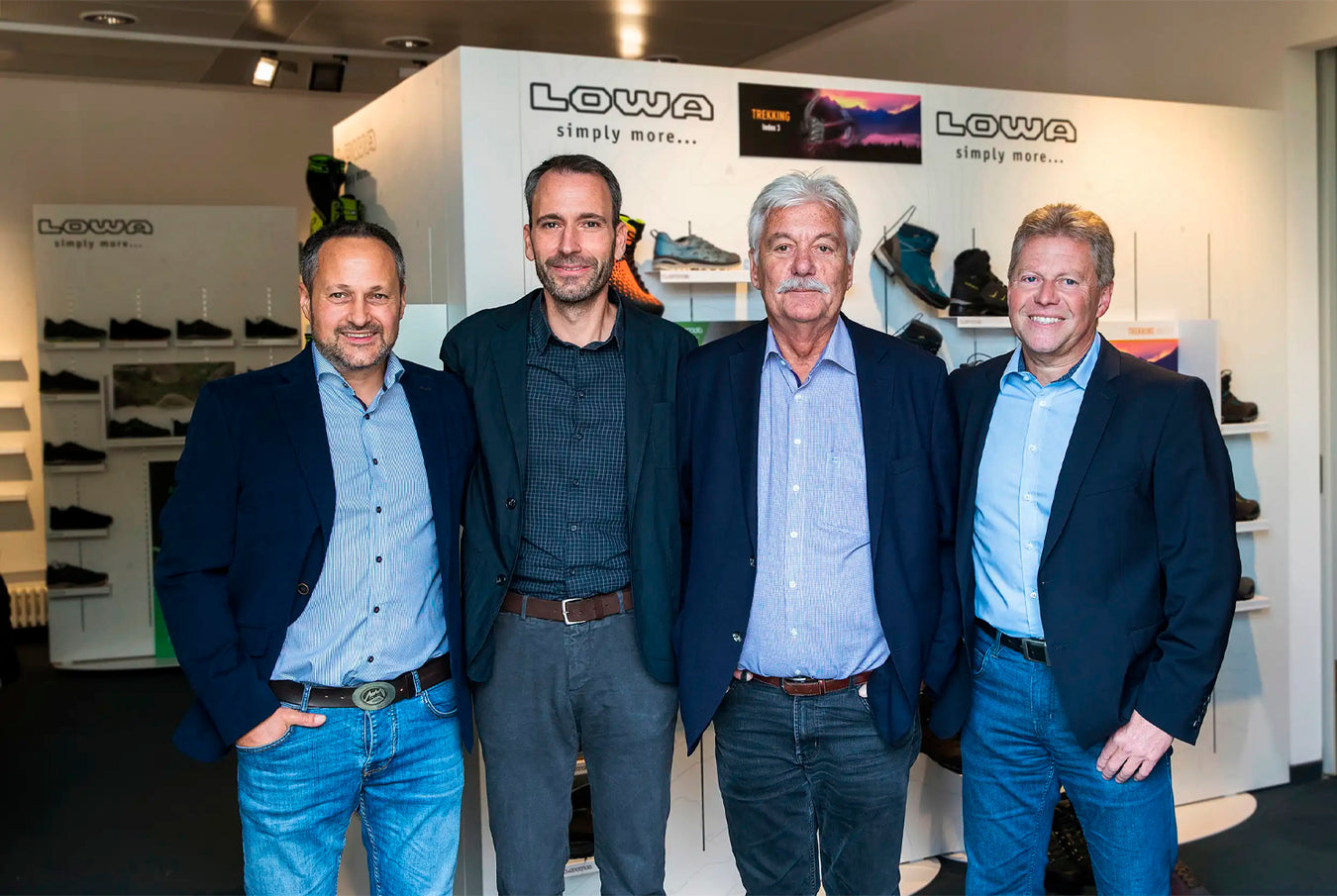Below are the most important stages of the long history from the beginning until today.
LOWA will celebrate its 100th anniversary in 2023.

1923 - 1931
THE TIME OF LORENZ WAGNER
Lorenz Wagner, the son of the shoemaker Johann Wagner, founded the LOWA company in 1923 in the quiet Jetzendorf, a town north of Munich. The name of the company comes from the first two letters of the owner's first and last name LOrenz WAgner. Passion for shoes and the skill required to make them are literally part of the family's DNA - a fact highlighted by the decision of his two brothers, Hans and Adolf, to start their own shoe companies as well. Lorenz Wagner was a genius for ingenuity and was also a passionate shoemaker. He spent hours and days until the end working on battens, patterns and soles. The success story began with the production of traditional Bavarian Haferl shoes.
PASSION LEADS TO PERFECTION
Lorenz's work laid the foundation for the company's future success. For him, the product was only ready when it fit and worked perfectly. He used the best leather in the region and built stable uppers and soles. The result was durable, timeless and high-quality shoes. The high quality of Norwegian welding shoe craftsmanship – a manufacturing process originating in the mountains – required Lorenz Wagner to expand his operations in the late 1920s. The first factory buildings were built for this purpose in 1930 and 1931. The basis of success was created by mountain infantry alpine boots and laced ski boots. At that time, Sepp Lederer, the future son-in-law and heir to the company, joined the company as an apprentice.


1929 - 1953
DIFFICULT TIMES
In the 1930s and 1940s, dramatic events led to global economic problems. The Great Depression paralyzed the United States from 1929 to 1941 and indirectly led to a worldwide recession that lasted about 12 years. The Second World War also broke out in 1939.
But Lorenz Wagner still managed to steer his company through difficult times. The effects of the Korean crisis shook the company strongly in 1949 and 1950. As a result of the crisis, the price of the material jumped up to 50 percent – leather became the target of speculators. The increase in costs increased the cost of production, while the increase in product prices suppressed demand. In order to be able to operate, LOWA had to pay high prices for materials. When prices suddenly dropped while the company was still trying to pay old bills, the company became insolvent practically overnight. When Lorenz Wagner died in 1953, LOWA reached the lowest point in its nearly 100-year history.
1937 - Vitale Bramani and Ettore Castiglioni invented the Vibram® rubber sole in July and tested it on several mountaineers.



1955 – 1988
SECOND GENERATION
In 1955, Wagner's daughter Berti and her husband Josef “Sepp” Lederer took over the company. He had joined the company in 1931 as an apprentice. He expanded the product range step by step, reflecting the founder's own philosophy.
LOWA created a sensation in 1957 when it was allowed to supply equipment to the Karakorum Expedition. Fritz Wintersteller, Marcus Schmuck, Kurt Diemberger from Salzburg and Hermann Buhl from Tyrol reached the summit of the 8,047m Broad Peak on June 9, 1957 during an expedition. From then on, sponsoring expeditions and athletes was a permanent part of LOWA's strategy – and it still is. One successful expedition followed another, which created opportunities to highlight the quality of LOWA products and add new innovations to product development. In the years that have passed since then, countless climbs in the Alps and expeditions to the most remote corners of the world have been added to the list.
NEW TECHNOLOGIES BRING SUCCESS
In 1970, Berti and Sepp recognized the signs of the times and started investing in new plastic technology, techniques that enabled the creation of ever more innovative products. Shortly after the decision was made, one of the first polyurethane injection molding machines was commissioned. The first vulcanized rubber soles – a ground-breaking innovation – were introduced: it combined 100% moisture protection, cold insulation and shape retention in one product.
LOWA also became a successful motorcycle manufacturer in the 1970s. The division's success was based on the "air" system introduced in 1972, which created an optimal fit with the help of air cushioning. LOWA also added innovative accents to the process. The success was finally reflected in the turnover of 1977, which made the expansion of the company inevitable. Two new factory halls were then built at the company's home base in Jetzendorf, and the company was able to put the insolvency nightmare of the 1950s behind it.
In the 1980s, a successful business strategy based on continuous innovation was continued. In 1982, the "TREKKER" model went on sale and gave birth to the hiking shoe.



1988 – 1996
CONTINUITY AND CHANGE
After 33 years, during which Sepp and Berti Lederer reshaped the company by introducing numerous improvements and won the company's bottom touch in 1950, they passed the management of the company to their son Stefan Lederer, the grandson of Lorenz Wagner, who ran the company in the third generation. Stefan Lederer systematically continued to apply the strategy introduced by his parents, for example by developing the LOWA STREET TREKKER.
THE BIRTH OF A SHOE EMPIRE
In the late 1980s and early 1990s, LOWA suffered severe financial setbacks due to several relatively snowless winters. In order to protect jobs in the company, the Lederer family decided to sell their share of the company.
As a result of this decision, in 1992 the company made a change in management that eventually took the company to incredible heights over the next 30 years – Werner Riethmann became CEO and led acquisition negotiations with the Italian company Tecnica in 1993. Tecnica Group is a company whose other brands include Nordica, Rollerblade, Blizzard and Moon Boot . LOWA was rebuilt for the future after this acquisition.
The company underwent a restructuring process. LOWA's mono division became part of Tecnica as part of this effort, ending LOWA's mono business. The company then focused entirely on the hiking and mountaineering shoe segments. LOWA's internationalization also became a priority. A move aimed at reducing the company's dependence on its three main markets: Germany, Austria and Switzerland. Jetzendorf remained the production site in Germany - which was one of Riethmann's key requirements - and also continued to be the base for the company's management team and its research and development department. Mountain climbing and hiking shoes also continued in Jetzendorf. The 15 square meter shop where Lorenz Wagner started developing his shoes had developed into a modern factory with a space of 7,000 square meters. Sepp Lederer and his wife Berti were awarded for their life's work and became honorary CEOs of the company after the acquisition.
In the following years, LOWA moved in only one direction: straight up. In 1994, a total of 1,750 pairs of shoes were produced in Jetzendorf every day. Further expansions regarding products, structures and sales markets soon followed. The company's offices and warehouses were also expanded in the following years. Introduced in 1995, the "light" hiking shoe is considered the forerunner of today's multifunctional All Terrain Classic collection. In the summer of 1996, LOWA established a joint venture in the United States. A Canadian version followed a few months later. At that time, the models TREKKER and LADY SPORT were the best-selling items.

1997 – 2004
BREAKTHROUGH
An exciting idea in development laid the foundation for a new product category of multifunctional shoes. The first RENEGADE went on sale, the best-selling model - which was available in almost 100 different models more than 20 years later. The lightweight "everywhere planer" is one of the best-selling outdoor shoes in Europe - 5 million pairs were sold in 2017.
Before the RENEGADE was introduced, heavy, cemented hiking boots were the only option for consumers. There were no light models for short trips. It was impossible to reduce the weight of the shoe when the cemented construction method was used. A completely new technology for outdoor footwear finally produced a solution. The bottom was no longer cemented. Instead, they were directly injected and thus attached to the cover.
In the following years, LOWA shoes went on sale for the first time in Spain, Portugal and Andorra. At the same time, the company continued to expand its market position in Europe.
In 1998, LOWA sold about 600,000 shoes and its turnover was about 70 million German marks. From this starting point, the company entered the new millennium with a wide range of products. The business was very successful and LOWA constantly increased its market position. Sales cooperation with Performance Sport Russia also laid the foundation for a new, important step in internationalization.
Another important goal was achieved just after the end of the year 2000. Thanks to innovative products and the highest "made-in-Europe" quality, LOWA produced and sold more than one million pairs of boots and shoes in one year for the first time. LOWA had become an established name in the European footwear and sports trade. Nevertheless, LOWA remained true to its traditions and roots and celebrated its 80th anniversary in 2003. By far the largest employer in rural Jetzendorf expressed its strong commitment to its production site and its base in Germany.


2005 - today
GLOBAL SUCCESS
In 2005, LOWA conquered China and thereby expanded to the Asian market: The partnership with the Chinese Nanjing Biancheng Sports started promisingly.
Just 10 years after breaking the magical million mark, the company achieved another long-sought goal. In 2010, LOWA sold more than 2 million pairs of shoes and overshadowed the economic crisis that raged since 2008. To achieve this goal, the company wrote a new chapter in its impressive history of success and secured its position as an important partner for retailers all over the world. Werner Riethmann was awarded the Bavarian Badge of Merit in 2011 for his vision and commitment to the region as CEO.
In 2013, LOWA celebrated its 90th anniversary with about 250 employees at a huge mountain festival. A success formula based on innovation and expansion has produced continuous progress in recent years. Starting in 2015, LOWA began manufacturing its shoes across Europe with production partners in Slovakia, Bosnia, Italy and Croatia. LOWA, in cooperation with its PRO team members, designed a collection that set new quality standards in 2017.
THE BEGINNING OF A NEW ERA
After working at the company for more than a quarter of a century, Werner Riethmann decided in 2019 to gradually withdraw from operational business and brought in his successor, the new CEO Alexander Nicolai. The new management, which also included Matthias Wanner (CSO) and Rudolf Limmer (CFO), started work the following year.
LOWA's workforce increased from 250 to more than 2,000, in July 2019, after Riko Sport bought a company already manufacturing LOWA footwear in Italy and Slovakia. At the same time, the long-term partner became a wholly owned subsidiary of LOWA Sportschuhe GmbH.
With an annual production of almost 3 million shoes, LOWA is now one of the leading camping and outdoor footwear brands in Germany, Austria and Switzerland. LOWA sells its products to 75 export countries and sponsors more than 30 athletes as part of the LOWA PRO Team, LOWA ACTIVE Team and LOWA CLIMBING Team.




